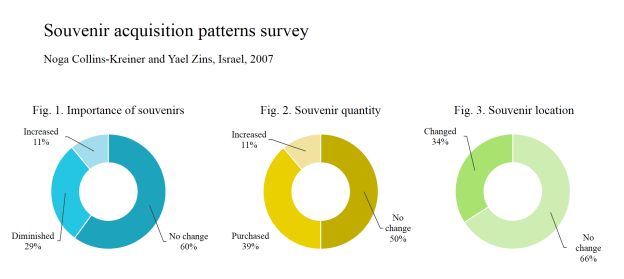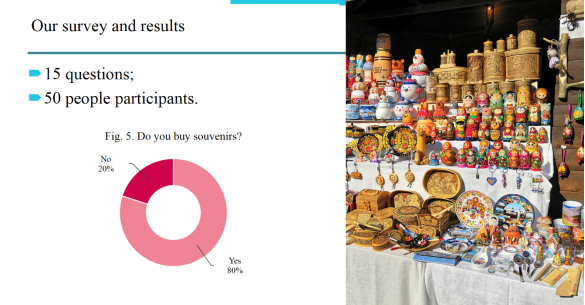Souvenirs industry is a significant component of tourism, but not enough attention is paid to it both in the theory and in practice. This study is dedicated to the importance of souvenir products for tourism and tourists. The article deals with several facts from the history of souvenirs, and the results of two types of research on the souvenirs acquisition patterns are given.
Keywords: souvenir industry, souvenir history, souvenirs acquisition patterns, Israel survey, respondents, destination.
The purpose of the article is to show how souvenirs industry changes from past to present. At first, the article presents interesting facts from the history of souvenirs in the article. Then the role of importance of souvenirs shows across the survey of souvenirs acquisition patterns. In the conclusion of the study, the authors describe their survey and introduce the results.
History of souvenirs
The souvenir is a special phenomenon in tourism. «‘Souvenir' is a French word meaning «to get back to myself»» [1, p.18]. It is a subject that reminds a tourist about trip and emotions, which he experienced. It can be the things bought in souvenir shops and things, which used during the travel (for example, tickets, checks, maps, etc).
The history of souvenirs begins with the most ancient times. The first prototypes of souvenirs appeared in Ancient Egypt. They were found at the excavation of ruins of the ancient cities and tombs. These were the reduced copies of household pieces, for example, of ware or weapon. People believed that these things will be necessary for the souls of the dead. Also in Egypt, people liked to present souvenirs to gods.
In the period of the Middle Ages people brought from crusades of a particle of the Holy Sites, for example, the earth or stones from temples to show that they participated in these campaigns. But then motives of travel exchanged, and people began to travel to increase the knowledge of the world around.
During this time a set of various souvenirs appeared. For example, in 1893 the World Fair in Colombia made popular a teaspoon. In the seventies, the 19th centuries in Austria-Hungary created the «correspondent card» similar to a modern postcard.
Souvenirs were considered as the most real family relics and were transferred to each other from generation to generations. Now before tourists, the wide choice of souvenirs is presented, beginning from knickknacks and finishing with useful things [5, URL].
Researches
In 2007 Israel researchers Noga Collins-Kreiner and Yael Zins carried out the survey of souvenirs acquisition patterns. 211 people participated in the survey.
As a result of the survey, souvenirs were divided into 2 groups: touristic articles and non-touristic articles. Touristic articles are the things created for sale to tourists and the things found independently. Non-touristic articles are household objects that became souvenirs after return home.
Тhe results distributed on groups “Importance of souvenirs”, “Souvenir quantity” and “Souvenir location”.
During the time the importance of souvenirs at 40 % of respondents changed. The main reason for the diminishing importance of souvenirs is increased tourist experience.
Besides, «38 % of participants reported that the quantity of the acquired souvenirs purchased, 49 % reported no change and only 13 % reported an increase» [1, p.22–23]. The main reasons for the reduction of the number of souvenirs are numerous trips to the destination and diminishing importance of souvenirs.
In addition, «the location of souvenirs in houses of tourists changes. Most of the participants of survey (66 %) specified that their souvenirs have remained in the same place over the years, while one third (34 %) indicated a change in the location of souvenirs in their homes [1, p. 23]. Change of location was influenced by a change in the aesthetic taste of the tourist change, reduction or increased importance of a souvenir and the shortage of the place in houses [1, p.17–27].

Fig.1. The results of Israel souvenirs acquisition patterns survey [1, p.17–27]
Authors of this article decided to carry out a similar survey. It is based on the structure of the Israel survey. 35 students and 15 adults participated in the survey. The purpose of the research work is to study whether the people’s opinion of souvenirs has changed 12 years later.

Fig. 2. The statistics and results of the author's survey [4, URL]
Primarily, 80 % of interviewed people answered that they continue buying souvenirs. Participants also divided souvenirs into 2 groups: touristic articles and non-touristic articles.

Fig. 3. The results of the survey distributed on the same groups [4, URL]
In addition, 48 % of respondents answered that the importance of their souvenirs changed. Participants allocate with the main reason for the change of the importance of souvenirs is diminishing the uniqueness of souvenirs.
Besides, 39 % of respondents noted that they bought fewer souvenirs on trips. Many interviewed people noted that instead of the purchase of souvenirs they more take photos of destination. Some people began to buy foreign food and sweets and therefore the value of these souvenirs grew.
In summary, 20 % of respondents noted that the location of souvenirs in the house exchanged. In many respects, it depended on the shortage of place in the house.
Conclusion
Importance of souvenirs for tourists during the time was shown in this article. On the basis of the shown researches it is possible to draw a conclusion that people continue to buy souvenirs, but already in smaller quantity. It is influenced more by reduction of the uniqueness of souvenirs, mass production of souvenirs and improvement of photography equipment. Many people during the trip began to buy non-standard souvenirs, therefore, they are considered more valuable, than the others.
References:
- Collins-Kreiner, N., Zins, Y. Tourists and souvenirs: changes through time, space and meaning // Journal of Heritage Tourism.2011.Vol. 6.№ 1.p. 17–27.
- Paraskevaidis, P., Andriotis, K. Values of souvenirs as commodities // Tourism Management.2015. № 48. p. 1–10.
- Annabel Fenwick Elliott. The curious history of holiday souvenirs — what compels us to buy them? // The Telegraph. URL: https://www.telegraph.co.uk/travel/arts-and-culture/history-of-holiday-souvenirs/ (accessed 17.05.2019)
- Authors’ survey and results // Google Forms. URL: https://docs.google.com/forms/d/e/1FAIpQLSdttjM9ygbRSVmJq0JSGLlA6gTW7Cm34GgfnXq8TfCsUP9ong/viewform?usp=sf_link (accessed 12.04.2019)
- History of souvenirs // Akitoza.ru URL: http://www.akitoza.ru/articles/historysuvenir (accessed 11.05.2019)







